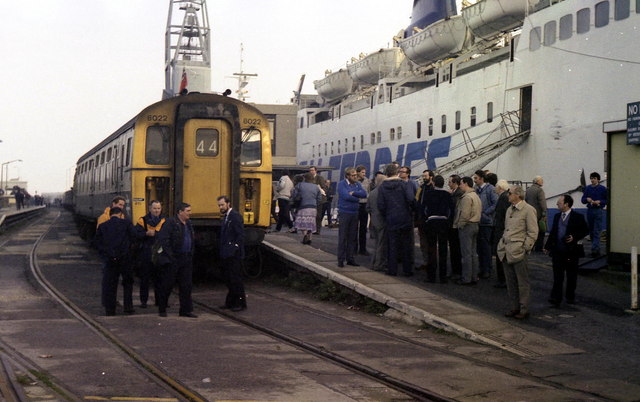- British Rail Class 438
Infobox Train
name = British Rail Class 438 (4-TC)
background = #D5005E
imagesize = 300px
caption = Class 438 unit at Weymouth Quay
InService = 1966–
Manufacturer = BR/BREL York
Family=BR Mark 1 EMU
Constructed=1966–1967, 1974 (converted)
Formation = 4 car sets - DTSO-TFK-TBSK-DTSO
numberbuilt = 34 sets, 1 spare DTSO
designation=401–403, later 8001–8034
Weight = DTSO: convert|32.5|t
TFK: convert|35.4|t
TBSK: convert|33.6|t
Total: convert|134|t
Capacity = 42 First, 160 Standard
Operator =British Rail
Depots = Bournemouth TMD
CarLength=DTSO: convert|19.70|m|ftin
TFK/TBSK: convert|19.65|m|ftin
CarWidth=convert|2.82|m|ftin
MaxSpeed = convert|90|mph|km/h|0
Brakes = Air (EP/Auto)
Engine =
Gauge=RailGauge|sg
SafetySystem=AWS|TheBritish Rail Class 438 (or 4-TC) were unpowered fixed formation 4 carriage set (fitted with driving cabs at each end) converted by BR atYork Works from locomotive-hauled Mark 1 carriages in1966 -1967 and1974 . The units built on experience gained from the prototype 6TC unit.Operation
The units were primarily employed on services between London Waterloo and Weymouth. One or two Class 438 units would be propelled from London to Bournemouth by a Class 432 unit, controlled from the leading Class 438 cab. At Bournemouth, one Class 438 (or maybe both if there were two) would continue over the unelectrified line to Weymouth, hauled by a Class 33 diesel locomotive, leaving the Class 432 unit behind. Up trains from Weymouth would follow the same procedure in reverse: the Class 33 locomotive would propel the Class 438 unit(s) as far as Bournemouth (controlled from the Class 438 leading cab). There the Class 438(s) would couple to the waiting Class 432 which would then power the whole formation to London, leaving the Class 33 locomotive at Bournemouth. Class 438 units were occasionally seen on other duties, such as the
Clapham Junction toKensington Olympia shuttle, before that line was electrified and surplus units were also used on Sundays to operate Portsmouth Harbour to Reading direct services during the late 1970's & early 80's. They ventured further afield on special duties or railtours, including Birmingham, Cardiff, Barnstaple/Meeth & Meldon Quarry.The spare DTSO number 76331 was equipped with a modernised interior - the seats were replaced with "Inter-City" style individual bucket seats (as used in the contemporary Mk2A/B/C carriages) and fluorescent lighting to match. This modified car was then placed into unit 417 from the early 1970s, and the displaced 76302 was kept spare at Bournemouth Traction Maintenance Depot. No general refurbishment was ever undertaken on the units and they ran with their original incandescent lighting until withdrawal. A feature of a journey in a 2x4-TC/4-REP train, with the 4-REP pushing, was severe jolting at station restarts; this upset many a hot drink over the years. There would be sometimes several jolts of varying intensity until the couplings were fully compressed. The Units were fitted with a motor-generator set for lighting supply and a single compressor; these drew power from the REP or loco through the ETH jumpers.
Description
The units were built in two batches. In the first batch, a total of 123 locomotive-hauled Mark 1 carriage were converted comprising 63 TSO to DTSO on Lot 30764, 32 BSK to TBSK on Lot 30765 and 28 FK to TFK on Lot 30766.
In the second batch, 14 locomotive-hauled carriages were rebuilt comprising 2 BSK to TBSK on Lot 30855, 6 FK to TFK on Lot 30856, and 6 TSO to DTSO on Lot 30857.
Individual vehicle numbering is shown in the table below.
Wikimedia Foundation. 2010.
